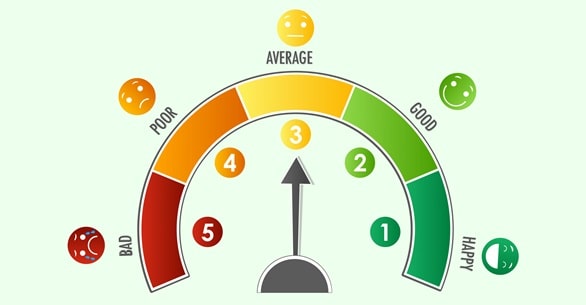The rating scale system is a commonly used method to evaluate or measure something. It is widely used in various fields, including education, customer feedback, employee performance, and product reviews. A rating scale typically involves assigning a score or a number to indicate the level of satisfaction, performance, or quality. These scores can range from 1 to 5, 1 to 10, or even in descriptive terms like “Poor,” “Good,” and “Excellent.”
In this article, we will explore the advantages and disadvantages of the rating scale system in simple terms so that anyone can easily understand its pros and cons.

Advantages of the Rating Scale System
1. Easy to Use and Understand
One of the biggest advantages of the rating scale system is that it is very simple to use. Whether you are a customer rating a product or an employee getting feedback from your manager, the rating scale system is easy to understand. People can quickly give their opinions by selecting a number or a label on the scale. This makes it a convenient tool for collecting feedback.
For example, in customer surveys, instead of writing long comments, customers can easily select a rating on a scale from 1 to 5, indicating their satisfaction with a product or service.
2. Quantifiable Results
The rating scale system provides quantifiable results, which means that the responses can be measured in numbers. This is very useful for analyzing data. For instance, if a company wants to know how satisfied its customers are with their service, they can collect ratings and calculate the average score. This gives a clear picture of the overall satisfaction level.
Quantifiable results make it easier to compare data over time, between different groups, or against benchmarks. This helps organizations in making data-driven decisions and improvements.
3. Time-Saving
The rating scale system saves a lot of time, both for the person giving the feedback and for the person analyzing the results. Filling out a rating scale takes only a few seconds compared to writing a detailed review or answering open-ended questions.
For businesses, analyzing hundreds or thousands of customer reviews can be very time-consuming. However, with the rating scale system, the results are presented in numerical form, which can be quickly analyzed using statistical tools.
4. Consistency in Feedback
Rating scales ensure that the feedback collected is consistent. Since all participants are asked to rate based on the same scale, the responses can be easily compared. This consistency is especially important in performance evaluations or customer satisfaction surveys where different people are providing feedback on the same topic.
For example, if employees are being evaluated on a 1 to 5 scale for different skills, the manager can compare their performance consistently across various parameters.
5. Customizable
The rating scale system is highly customizable. It can be adjusted to suit different needs and situations. For instance, businesses can use a 5-point scale, a 10-point scale, or even descriptive labels like “Very Poor,” “Poor,” “Average,” “Good,” and “Excellent.”
This flexibility allows the rating scale system to be tailored to specific requirements, making it a versatile tool for various industries and purposes.
Disadvantages of the Rating Scale System
1. Subjective Responses
One of the main disadvantages of the rating scale system is that it can lead to subjective responses. What one person considers a “4” on a 5-point scale might be viewed as a “3” by someone else. This subjectivity can make it difficult to get an accurate and clear understanding of the feedback.
For example, in performance reviews, different managers may have different interpretations of what constitutes a “Good” performance. This can result in inconsistent ratings, which might not reflect the actual performance.
2. Limited Depth of Information
While the rating scale system is quick and easy to use, it often lacks depth. It provides a numerical score or a label but does not explain the reasons behind the rating. This can be a limitation when businesses or organizations need more detailed feedback to understand specific issues or areas for improvement.
For instance, if a customer rates a product as “3” out of 5, the company may not know why the customer was not fully satisfied. Without additional comments or explanations, it becomes difficult to make targeted improvements.
3. Central Tendency Bias
Central tendency bias is a common issue in rating scales, where respondents tend to avoid giving extreme ratings (like 1 or 5) and prefer to select ratings in the middle of the scale (like 3). This can result in inaccurate feedback, as it may not truly reflect the respondents’ opinions.
For example, in employee performance reviews, some managers may hesitate to give very high or very low ratings, even if an employee deserves it. This can lead to average scores that do not provide a true picture of the employee’s performance.
4. Misinterpretation of Results
The rating scale system can sometimes be misinterpreted by the person analyzing the results. A high score may not always mean that the respondent is completely satisfied, and a low score may not indicate complete dissatisfaction. Without additional context, the results can be misleading.
For instance, a customer may rate a product as “4” out of 5, but their expectations might have been much higher. Without knowing the customer’s specific expectations, the rating alone might give a false sense of satisfaction.
5. Over-Simplification of Complex Issues
Another disadvantage of the rating scale system is that it can oversimplify complex issues. Many situations or experiences cannot be accurately summarized by a simple number or rating. This is especially true when it comes to evaluating emotional experiences, long-term performance, or highly subjective opinions.
For example, a movie rating of “3” out of 5 does not convey the complexity of a viewer’s emotions or thoughts about the film. The viewer may have liked certain aspects but disliked others, and the overall rating may not capture the full experience.
Conclusion
The rating scale system is a widely used method for gathering feedback and evaluating performance. It offers several advantages, such as being easy to use, providing quantifiable results, and saving time. However, it also has its limitations, including the risk of subjective responses, limited depth of information, and potential biases.
While the rating scale system is useful in many situations, it is important to recognize its limitations and, where necessary, supplement it with additional methods, such as open-ended questions or detailed comments. This way, organizations and individuals can get a more complete and accurate understanding of the feedback they receive.



